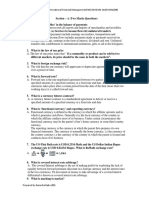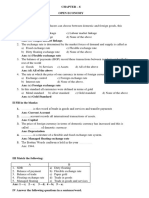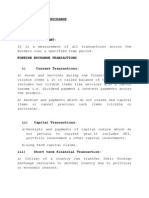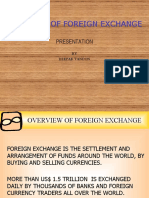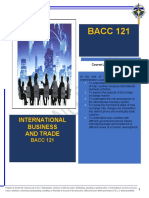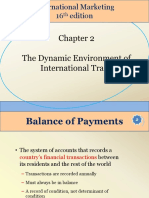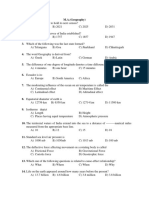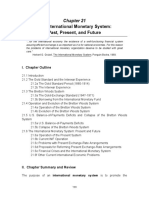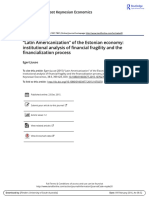Suggestions
Q.1. Explain the dictum “Banks deal with documents not in goods”-
Discuss the rights and responsibilities of the negotiating bank under a
documentary credit.
2.Duties and responsibilities of Issuing and Negotiating banks under a
documentary letter of credit.
3. (a).What is Balance of Payment? How does the BOP position impact
local currency apptriciation/depreciation?
(b). What are the components of the current account and the financial
account of BOP?
(c).Define foreign exchange market.How is price exchange rate)
determined under a floating exchange regime like Bangladesh.
�4. What is floating exchange rate ? How Balance of payment and Balance
of trade are affected due to fluctuation of exchange rate?
5. What is Exchange position ? What are the component of exchange
position? What are the risk associated with over sold or over bought
position?
6.What is forward transaction? What are the risk associated with
forward transaction? How banks can minimize the risk due to clients
forward transactions?
7.(a).What is wage earners remittance?
(b). What is foreign exchange reserve? Why it is important for for the
economy?
8.(a).Price verification is very crucial in cross-border transactions. How
can you justify price while initiating LC or contract?
(b). How does under/over-invoicing impact the exchange rate and the
economy as a whole?
�(c). Suggest your policies to minimize the scope of under/over-invoicing
in cross-border trade.
9. (a).Buyer’s credit has become very popular worldwide including
Bangladesh. What are the possible reasons for its popularities and also
mention some drawbacks of using the buyer’s credit.
�• (b). What is transferable and standby LC? Describe the standard operational
procedure of transferable and stadby LC in Bangladesh.
• 10.(a).Define open accounts in cross-border trade. Do you think export under an
open account is generally allowed, having no payment guantee?
• (b).Describe the sattlement methods for export and import:
• i).Letter of Credit
• ii). Sales contract or Open account
• iii). Advance Payment
• 11(a).Describe the incentives and facilities offered to the Non-Resident
Bangladeshi against their homebound remittance through banking channels.
• (b).How do you motivate your bank clients in favour of a formal or banking
channel instead of a risky ‘Hundi’ channel for receiving remittance?
• (c). Inward wage remittance is an important factor to keep BOP favourable and
exchange rate stable. Explain it in your own words.
�• Distinguish between any four of the following:
• (a) OD Sight and BC Selling Rates;
• (b) Spot and Forward Exchange Rates;
• (c) Nostro and Vostro Accounts;
• (d) Loan against Imported Merchandise (LIM) and Lon against Trust
Receipt (LTR)
• (e) Pre-Shipment Finance and Post Import Finance;
• (f) Currency Appreciation and Depreciation.
• (g).Fixed Exchange Rate and Floating Exchange Rate;
• (h) Devaluation and Stagflation;
• (i) Clean Bill of Lading and Dirty Bill of Lading;
• (j) FDBP and FDBC.
�• Distinguish between any four of the following:
• (k) Euro and Euro Dollar;
• (l) Proforma invoice and Commercial invoice;
• (m) Mate's receipt and Bill of lading;
�• Write short notes on any five of the following:
• (a) Back-to-back Letter of Credit;
• (b) NITA Account;
• (c) Net Open Position (NOP) of Foreign Exchange;
• (d) Factoring;
• (e) Travel Quota;
• (f) Wage Earners' Development Bond;
• (g) Bill of Exchange;
• (h) Lodgment of Import Dill;
• (i) Transport Documents in LC;
• (j) Standby Letter of Credit;
• ( k) Balance of Payments;
• (l) UPAS L/C.
�• Write short notes on any five of the following:
• (m) Proforma Invoice;
• (n) Forced LIM;
• (o) LIBOR;
• (p) Packing Credit;
• (q) SWAP;
• (r) Irrevocable Letter
�Q.Based on the following information, please calculate the buying and
selling rate of Bangladesh taka per Japanese Yen when inter bank
market exchange rate was.
• USD1= JPY 130.3010-132.1280
• USD1-BDT 106.1010-107.7590
• Also calculate the amount of BDT to be paid by your bank for buying
2.00 million Japanese Yen.]
• Solution
• Culculate buying rate :
• In case of Buying maxim is buy low
• US$ 1 = Japanese Yen 130.3010
• US$ 1 =Bangladeshi Taka 106.1010
�• Conversion of US$ in terms of JPY by multiplying
• Or 1x130.3010 JPY=106.1010BDT ( As US$ 1=130.3010 JPY)
• I,e 130.3010 JPY= 106.1010 BDT
• There fore 1 JPY=106.1010 BDT/130.3010= 0.81427617544 BDT
• There fore to buy 2.00 million JPY, the bank will
pay=2000000x0.81427617544BDT=1628552.3508BDT
�• Culculate selling rate :
• In case of Selling rate the maxim is sell high
• US$ 1 =Japanese Yen 132.1280
• US$ 1=BDT107.7590
• Multiplying the rate of US$ by JPY
• US$ 1= 107.7590 BDT
• or, 1x132.1280 JPY=107.7590BDT ( as 1US$=132.1280 JPY)
• Or, 132.1280=107.7590 BDT
• There fore, 1 JPY=107.7590BDT/132.1280=0.81556520914BDT
• So, For Selling of 1 Yen has to pay as per Bangladeshi Taka
0.81556520914.
�• Balance of Payments:
• According to Kindle Berger, "The balance of payments of a country is a
systematic record of all economic transactions between the residents
of the reporting country and residents of foreign countries during a
given period of time".
• It is a double entry system of record of all economic transactions
between the residents of the country and the rest of the world carried
out in a specific period of time.
• How does the BOP position impact local currency
appreciation/depreciation?
• A deficit in the balance of payments leads to a higher demand for
foreign currency to the harm of national currency which would
depreciate in this situation.
�• The balance of trade surplus influences the exchange rate of the
national currency in the sense of its appreciation. But on the other
hand, a strong currency stimulates imports and inhibits exports. The
decrease in exports (the increase in the deficit of the balance of trade)
shows its effects in the depreciation of the national currency.
• A weaker currency stimulates exports that will receive more units from
the national currency. Thus,an exceeding balance of trade is reached
and the balance of payments finds its equilibrium.
• (b).The various components of a BOP statement
• 1. Current Account
• 2. Capital Account
• 3. Reserve Account
• 4. Errors & Omissions
�• What are the components of a currentaccount,capital account and
financial account?
• The components of current accounts include goods, services, unilateral
transfers and investment income.
• However, the components of capital accounts contain foreign direct
investments and foreign portfolio investments.
• The financial account covers all transactions associated with changes of
ownership in the foreign financial assets and liabilities of an economy.
• Financial account components include direct investment, portfolio
investment, and reserve assets broken down by sector.
�• 4. What is floating exchange rate ?
• A floating exchange rate is a regime where the currency price of a
nation is set by the forex market based on supply and demand relative
to other currencies.
• A floating rate is based on supply and demand in the open forex
market. If the demand for the currency is high, the value will increase.
If demand is low, this will drive that currency price lower.
• How Balance of payment and Balance of trade are affected due to
fluctuation of exchange rate?
• When a country's exchange rate increases relative to another
country's, the price of its goods and services increases. Imports
become cheaper. Ultimately, this can decrease that country's exports
and increase imports.
�• A depreciation of the exchange rate may stimulate an increase in
remittances and transfer inflows and decrease outflows, improving the
current account balance.
• An increase in the real effective exchange rate may improve or worsen
the financial balance.
• In parts of the balance of payments, the exchange rate is one of the
important factors.
• Therefore, if the foreign exchange rate changes out of the control of
the market and governments, it can cause instability in the current
account or balance of payments.
• Moreover, changes in foreign exchange rates impact directly economic
activities such as good supply, investment, employment, or income of
citizens.
�• 5. What is forex position ? What are the component of exchange
position? What are the risk associated with over sold or over bought
position?
• What is a forex position?
• A Forex position is the total amount of currency owned by an individual
who trades the price movement of the currency against another.
• It mainly has three characteristics: the currency pair, size, and direct
(long or short).
• Exchange position is the new balance of the aggregate purchases and
sales made by the bank in particular currency.
• This is thus an overall position of the bank in a particular currency.
• All purchases and sales whether spot or forward are included in
computing the exchange position.
�• Position and Balance:
• The position in a foreign currency is the net difference between the
total sales and purchases of that currency on a particular day, where as
the balance refers to the balances, debit or credit, of the Nostro
account of a bank in that currency with its overseas branch or
correspondent.
Components of Exchange position:
(a)The transactions that go into the composition of the exchange
position in a given currency are the sales and purchases in that currency
for which a firm rate has been quoted, irrespective of whether such
transactions have been completed or not by the delivery of the currency.
�(b) In determining the exchange position, the sales and purchases are to
be classified into separate groups, together with the overbought or
oversold position, the resultant balance gives the exchange position.
• Overbought is a term used to describe when a financial instrument in
the market is considered to be trading above its "fair" value due to
abnormal levels of demand.
• Overbought situations are generally evaluated and interpreted by
comparing the last price of the relevant instrument or the price
average over a certain period.
�• If the demand for a financial instrument increases in a way that is
inconsistent with fundamental and technical analysis, and the price of
that instrument rises in direct proportion, it can be said that an
overbought transaction has occurred.
• Oversold is a term used to describe a situation in which the current
price of a financial instrument is trading at a lower value than the price
predicted by technical studies and therefore the possibility of an
upward price movement becomes clear.
• What happens when a financial instrument is overbought or
oversold?
• In simple terms, when the market is overbought, it means that the
asset has been overbought and may be ready to fall.
• Conversely, when the market is oversold, it means that assets have
been sold in excess and may be ready to rise.
�• Risk associated with overbought or oversold?
• Identifying when currency experience excessive buying or selling is
crucial:
• An overbought currency could signal its peak and potential decline;
conversely, an oversold currency may suggest it has droped to its
hardship with possible betterment on the horizon.
�• 6.What is forward transaction? What are the risk associated with
forward transaction? How banks can minimize the risk due to clients
forward transactions?
• What is a forward transaction?
• Forward transactions provide a means of protecting investments
against possible rate fluctuations.
• They are primarily used for speculative purposes. The buyer in a
forward transaction speculates on a rise in the value of the underlying
assets.
• For example, you enter into a contract to sell 100 units of a computer
to another party after 2 months at Tk. 50,000 per unit. You enter into a
forward contract.
�• Risks involved in Forward Contract:
• Counterparty Risk: A forward contract is an agreement between two
parties, and there’s always a risk that one party may default on their
obligation. This could result in financial loss for the other party.
• Market Risk: The value of the underlying asset can fluctuate between
the time the contract is made and the delivery date. This could result in
one party benefiting at the expense of the other party.
• Liquidity Risk: Forward contracts are not traded on an exchange and
are often illiquid. This could make it difficult for parties to exit their
position or find a counterparty to take the other side of the trade.
• Payment Defaults : If one party defaults on the contract, the other
party may be left with a significant financial loss. In addition, because
the contract is a private agreement, there is no guarantee that the
other party will fulfill their obligations.
�• What can the bank do to reduce the risk?
• Banks manage FX risk through various strategies, including using
forward contracts to lock in exchange rates, diversifying currency
holdings, and using derivatives like options and futures to hedge
against currency fluctuations.
• Exchange rate risk cannot be avoided altogether when investing
overseas, but it can be mitigated considerably through the use of
hedging techniques.
�7.(a).What is wage earners remittance?
(b). What is foreign exchange reserve? Why it is important for for the
economy?
• A wage earner is defined as a person who sells their labor as a
commodity in exchange for wages, typically without any obligations to
a specific employer.
• A remittance refers to the money sent by one party to another within
or outside the country. Remittance is one of the important source of
revenue for a country and plays a vital role in its economic growth and
development.
• In 1974, Wage Earners' Scheme was initiated in order to help the non-
resident Bangladeshis remit their earnings home through legal
channels.
• The scheme soon became popular among the Bangladeshi community
working abroad.
�9. (a).Buyer’s credit has become very popular worldwide including Bangladesh.
What are the possible reasons for its popularities and also mention some
drawbacks of using the buyer’s credit.
• Buyer's credit is a short-term loan to an importer by an overseas lender for the
purchase of goods or services. An export finance agency guarantees the loan,
mitigating the risk for the exporter. Buyer's credit allows the buyer, or the
importer, to borrow at rates lower than what would be available domestically.
• Risks and Challenges of Buyers Credit
• Currency risk. One of the main risks associated with buyer's credit is currency
risk.
• Credit risk. Credit risk is defined as the potential loss arising from a bank
borrower or counterparty failing to meet its obligations in accordance with the
agreed terms.
• Compliance risk:Compliance risk, also known as integrity risk, is the potential
damage businesses face when they fail to comply with industry standards,
laws, and regulations.interest rate risk.
• Transaction risk.Transaction Risk is the exposure to uncertainty factors that
may impact the expected return from a deal or transaction.













